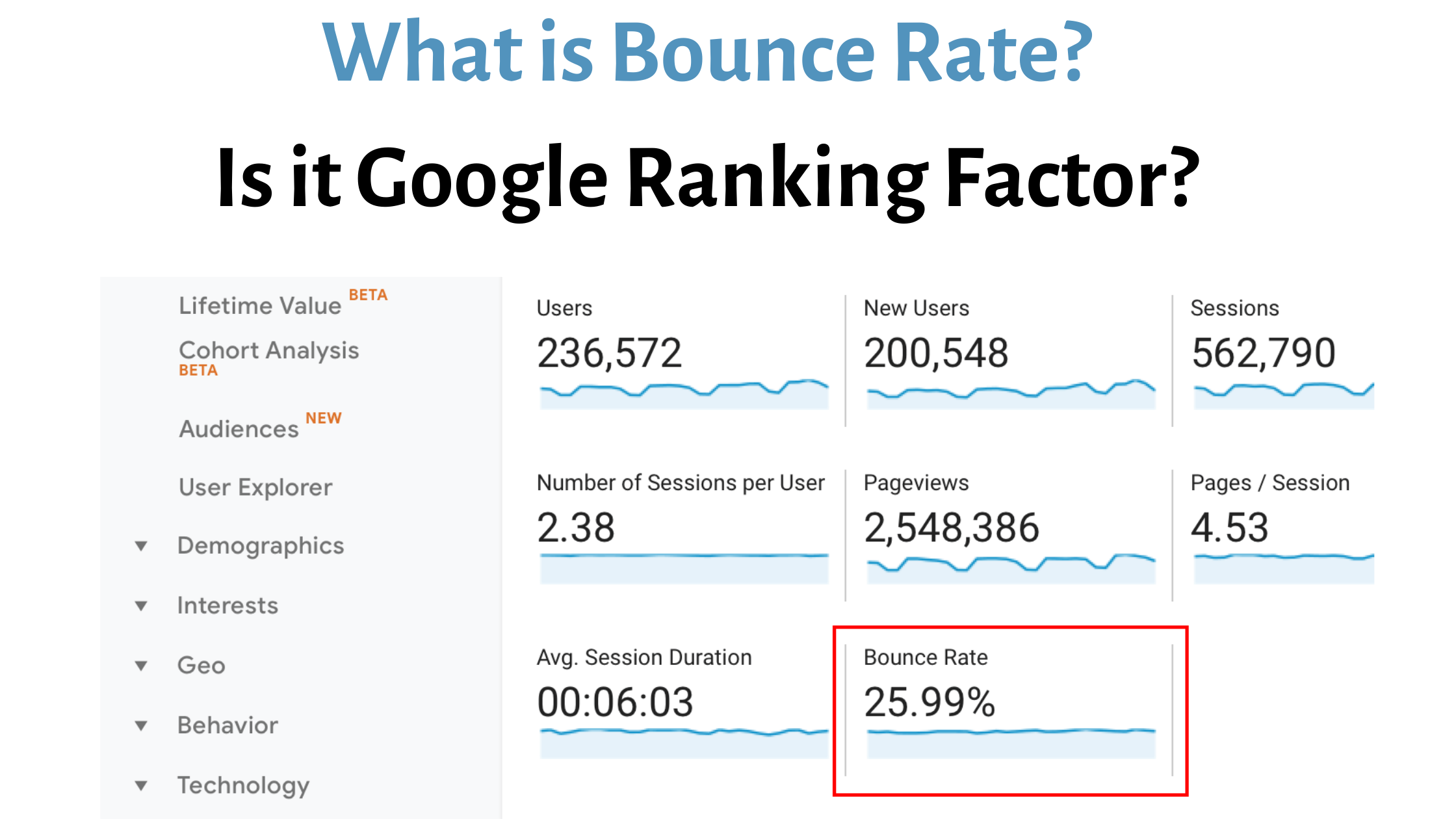If you are not a fresher in the SEO world, you must know what Bounce Rate means. To people who are not as well-versed, let us begin by understanding what Bounce Rate means. While the name might suggest that it’s a sports term, it has nothing to do with sports.
Bounce Rate is the percentage of visitors that leave a webpage without visit any other webpage.
The Claim: Bounce Rate as a Ranking Factor
There are many different things that affect the ranking of websites on Search Engines. However, in this article, we will be focusing on something that is not a ranking factor.
There are a lot of rumors afloat about the relevance of the Bounce rate in Google’s ranking. Many SEOs are under the misconception that having a good bounce rate is a guarantee for good search engine rankings. While a poor bounce rate is sometimes a cause of alarm, it’s not as bad as you think. The average Bounce Rate range is between 41 and 51% according to research by GoRocketFuel.com.
Even many SEO “experts” have been known to advocate Bounce Rate as a Ranking Factor. Misinformation doesn’t always stem from malice. Sometimes people just get carried away for clicks and views.
In this article, we will take a step-by-step approach to dissect why Google does not use Bounce Rate as a ranking factor. To new businesses that have just started working with Google Analytics, seeing a high bounce rate can be disheartening. But before you divert all your energy towards stabilizing the bounce rates, remember, it won’t change your google ranking. People need to find your website first, then only they can engage with it, right?
So, What is Bounce Rate?
When you open a website and instantly closed it, you can say that you bounced back from the website. The reason why someone might bounce from a webpage is multifold. They could’ve clicked on it by mistake, the content might not be relevant or they might’ve got the information they needed at a glance.
At its crux, bounce rate is a measure of how much the users engage with the content on the website. A high bounce rate signifies that the users don’t engage with the content and vice versa. However, Bounce rate does isn’t a good indicator of the quality of your site. Bounce rate is secondary to customer experience.
Bounce Rate as a Ranking Factor: The Evidence
According to a statement by John Mueller from Google, Google does not use bounce rate as a ranking factor.
Even Google’s Gary Illyes tweeted that “bounce rate is not a good signal.” almost 4 years ago in response to the surge in rumors about bounce rate’s importance in google ranking.
After a deep analysis of past trends, we found that the many keywords and pages that have ranked high in the SERP for years, still have shown a bounce rate higher than 95%. Therefore, it is evident that bounce rates are not a ranking factor.
Does Bounce Rate Affect Search Rankings?
Finally, the ultimate big question. The answer is one word and it is no. Google Search Engine’s organic ranking is unaffected by bounce rate.
But the answer is hardly ever simple when it comes to SEO and Analytics. A bad bounce rate indirectly affects other ranking factors that are important to Google. It is associated with slow page speed, low-quality design, poor mobile optimization, etc.
If your website page just won’t load or the design is incomprehensible, it is going to take a toll on your google rankings. Google cares a lot about user experience and ease of access after all. Your motive should be to create a page that has a low bounce rate and high time-on-page.
High time on page means your content is relevant and engaging. To create a good user experience, you need to establish a symbiotic relationship between time-on-page and bounce rate. Time-On-Page is a very important metric-A high time on page is a testament to your content quality.
Now let us uncover a bit more evidence about why Google does not use Bounce Rate as a ranking factor and why that isn’t likely to change anytime soon. We need to understand how search engines and google analytics work for this.
Why Google does not use Bounce Rate as a ranking factor
A click is registered when a user finds a relevant page in the search engine result page and opens the website. Google knows this due to the Google Analytics code implemented on the website. However, the point to be noted is that not all websites have Google Analytics code implemented.
It would seem like bounce rate cannot be calculated if the Google Analytics code was not installed on the website and might lead you to wonder if you can get away with a negative bounce rate by simply not installing Google analytics. Do you think Google would intentionally undermine its importance? Of course not.
Google measures retention rates by analyzing the time lapsed between another click by the user in the same environment. Simply put, a second click on another page can measure how long the user has been on the previous page.
The google analytics code isn’t written to detect things like mouse movement, scrolls on the page, etc.
It is still possible to calculate a website’s bounce rate without having the Google Analytics code. This can be done by detecting instances of “Pogo Sticking”. It is when a user clicks on a link from the SERP but then jumps back to the SERP. If a user does that, it could mean that they didn’t like the website’s content.
However, it could also mean that:
- The user opened various tabs and then returned to the SERP
- The user liked the content and saved it for later use. They could bookmark it or share it on a social media channel, and then return it to the SERP
- The user got the information instantly
Bounce Rate as a Ranking Signal: Our Rating
We can conclude through our empirical research, that Google does not use Bounce rates as a ranking factor.
Google has repeatedly said so. Bounce rates are just another metric that is important to create a good engaging user experience.
What can you do to improve your bounce rates?
Just working on improving your website-offer useful content, engaging blogs, and valuable information. Doing this will automatically improve your website’s bounce rates.
If you found this article useful or informative, do check out our other articles about SEO also. Happy learning!









